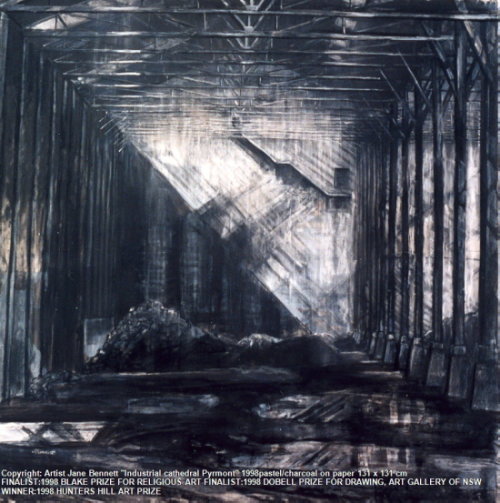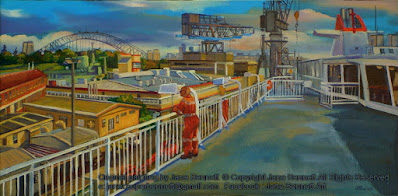In 2003, the State Government announced that the stevedoring wharves at East Darling Harbour, on the western edge of Miller's Point, known since the Depression as the 'Hungry Mile', would be transformed into a new urban precinct, which would later be known as Barangaroo.
The wharf has now closed forever and Sydney’s traditional role as a working harbour is essentially over.
For Sydney Harbour no longer to be a working port and to be stripped of its original character and purpose, was almost unthinkable.
I resolved to paint its hidden history before it was too late. This concrete expanse was often derided as 'ugly', usually by people who had never set foot on it, but I found it a rich and fascinating source of inspiration for a series of several hundred paintings.
I became 'Artist in Residence' in 2003, and was still painting there after the last wharfie left in October 2007. I always painted 'en plein air', even though the completed works have the compositional poise of a Jeffrey Smart.
DH135A 'Maintaining the crane' Diptych
2007 oil on canvas 51 x 25.5cm each panel
Available for sale
This was painted towards the end of East Darling Harbour's days as an operational wharf. I had often painted each of the 3 cranes on the wharf, although being able to get all three in a single canvas was nearly impossible. They didn't run on rails - they all had retractable stabilizers in the shape of pyramids, and these lifted to allow the cranes to trundle up and down the wharf on their rows of tyres.
I spent much of my time on the wharf chasing these wretched things up and down the wharf, in hot pursuit of my recalcitrant subjects. Even if their lower halves stayed put, they were raising, lowering, twisting and turning. I'd have to start 4 or 5 small canvases, each one with the crane in a different pose.
This crane was "L1" the oldest & most complicated of the 3 Liebherr
cranes known by the wharfies as "Big Bird" as apparently it was
originally yellow.
It was loathed by the wharfies as it was complex and rather over-engineered, so prone to breaking down. The L3 crane was much easier to operate and maintain, and incidentally, much easier for me to paint. If the L1 crane moved even slightly out of its original position, it was infinitely harder for me to predict what I should alter to adapt the old position to the new one. The result is that I have a lot more unfinished and unfinishable paintings of this crane than of the 2 others put together.

DH135A 'Maintaining the crane' left panel of Diptych
2007 oil on canvas 51 x 25.5cm each panel
Available for saleWhen I was painting on the wharves, all three cranes were red, which made them difficult to paint against the red Wallenius Wilhelmsen ships.
Although they were all a shade of red, and more than likely had been painted at the same time with the same brand of paint, each of the cranes was a different shade of red. Not just lighter or darker, but some were definitely more towards the pink than red. The L1 crane was a light- medium bluish pink, the sort of pink derived from mixing magenta or alizarin crimson with white. L2 veered between napthol crimson, Windsor bright red and in the more care-worn patches, the pink obtained by mixing white with cadmium red deep. L3 was in places almost a true red, requiring mostly cadmium red medium and even a few vermilion highlights. All these colours had very different properties, as the cadmium colours were very opaque and the alizarin and magenta were semi-transparent and took much longer to dry. They had one thing in common though, they were amongst the most expensive paints to buy - Series 4. 5 or 6. The prices go up exponentially from Series 1. Series 2 paints are about half as much again as the previous series, Series 3 half to two thirds as much as 2, etc, etc. As usually the cranes were in front of a red Wallenius Wilhelsen ship, which was a different hue of red again (usually cadmium red light), this meant that the art shops became seriously rich from my stint as 'Artist in Residence ' on the wharf. But to do justice to the scene in front of me I had to be true to the subtle nuances of the changing light and colour in front of me.

DH135A 'Maintaining the crane' right hand Diptych
2007 oil on canvas 51 x 25.5cm each panel
Available for sale
Later in 2007, all three cranes were painted yellow again in the AT & T colours. A couple were taken to Melbourne's Webb Dock, but 'Big Bird' was taken down to Port Kembla on the "Sea-Tow" barge.
It's still at Port
Kembla - I noticed it when I was painting the Port Kembla Copper Stack
before it was demolished in February 2014.
I painted this diptych in 2007 as it was undergoing much needed maintenance in front of Wharf 6, not long before its new paint job and long sea journey.
The odd looking object wrapped in white is a helicopter. Some of the wharfies had been discussing what would be the most difficult object to wrap as a birthday present, so that the recipient wouldn't be able to guess what it was. One of them suggested a tricycle, but I think the helicopter would have won that competition.
Related Posts






















